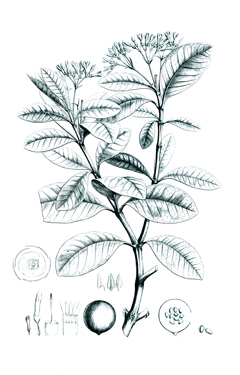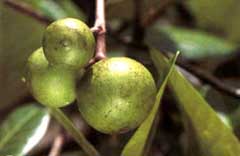 |
|
https://edibleplants.org/ |
 |
| nargil.ir |
Translate this page:
Summary
Sorva, Couma utilis, is a medium-sized tropical tree in South America that reaches up to 17 m in height with trunk diameter of up to 20 cm upon maturity. The leaves are simple and opposite or alternate in arrangement. The latex from the tree is used in the treatment of diarrhoea, worms, parasites, and skin irritations. It is also used to flavour drinks, caulking boats, and for varnishes, ceramics, glues, etc. The fruit is eaten raw. It is small, round, and has a fleshy sweet pulp. The wood is used in making cabinets, in carpentry and general construction. It is also grown as an ornamental. Also known as: Sorvinha, Sorva-miuda, Sorva-pequena, Cuma, Sowa, Sorva, Couba.
Physical Characteristics

 Couma utilis is an evergreen Tree growing to 12 m (39ft) by 10 m (32ft) at a medium rate.
Couma utilis is an evergreen Tree growing to 12 m (39ft) by 10 m (32ft) at a medium rate.
See above for USDA hardiness. It is hardy to UK zone 10.
Suitable for: light (sandy) and medium (loamy) soils and prefers well-drained soil. Suitable pH: mildly acid, neutral and basic (mildly alkaline) soils and can grow in very acid soils.
It can grow in semi-shade (light woodland) or no shade. It prefers moist soil.
UK Hardiness Map
US Hardiness Map
Synonyms
Collophora utilis Mart. Couma dulcis Spruce ex M?ll.Arg. Couma multinervis Monach.
Plant Habitats
Edible Uses
Edible Parts: Fruit Sap
Edible Uses: Drink Gum Sweetener
Fruit - raw[ 317 ]. Small and round, looking somewhat like a guava, with an edible sweet, fleshy pulp[ 377 , 420 ]. The flavour is like a mangaba (Hancornia speciosa) with a hint of sapodilla (Manilkara zapota)[ 418 ]. The brown, globose fruit is about 4cm in diameter[ 420 ]. The latex obtained from the tree has a sweet flavour[ 418 ]. It is used as a chewing gum and also to flavour drinks[ 377 ].
References More on Edible Uses
Medicinal Uses
Plants For A Future can not take any responsibility for any adverse effects from the use of plants. Always seek advice from a professional before using a plant medicinally.
Anthelmintic Antidiarrhoeal Antiseptic Skin
The latex obtained from the tree is anthelmintic and antiseptic[ 418 ]. It is eaten to treat diarrhoea, worms and parasites[ 377 , 418 , 739 ]. The latex is applied externally to treat skin irritations[ 418 ].
References More on Medicinal Uses
The Bookshop: Edible Plant Books
Our Latest books on Perennial Plants For Food Forests and Permaculture Gardens in paperback or digital formats.

Edible Tropical Plants
Food Forest Plants for Hotter Conditions: 250+ Plants For Tropical Food Forests & Permaculture Gardens.
More

Edible Temperate Plants
Plants for Your Food Forest: 500 Plants for Temperate Food Forests & Permaculture Gardens.
More

More Books
PFAF have eight books available in paperback and digital formats. Browse the shop for more information.
Shop Now
Other Uses
Adhesive Furniture Gum Latex Straw Varnish Waterproofing Wood
Other Uses: A latex is obtained from tapping the tree[ 317 , 377 ]. Used traditionally for caulking boats[ 317 ]. It is used for a variety of industrial purposes, including varnishes, for ceramics, glues etc[ 317 , 377 ]. The wood is fine-textured, straight-grained, moderately heavy, with moderate mechanical properties and of very low durability. It is used in cabinet-making, carpentry and general construction[ 420 ].
Special Uses
Carbon Farming Food Forest
References More on Other Uses
Cultivation details
Industrial Crop: Hydrocarbon Management: Hay Regional Crop
A tree of the moist, tropical lowlands where it is found at elevations up to 500 metres[[ 418 ]. It grows best in areas where the temperature ranges from 20 - 30°c, but is able to tolerate a range from 15 - 35°c[ 418 ]. It prefers a mean annual rainfall of 2,000 - 4,000mm, but tolerates from 1,500 - 5,000mm, and is found in areas with a distinct dry season as well as areas of all year round rainfall[ 418 ]. Succeeds in full sun or dappled shade[ 420 ]. Grows wild on white sand soils[ 418 ]. Prefers a pH in the range 4.5 - 6, tolerating from 4 - 6.5[ 418 ]. Established plants are drought tolerant[ 420 ]. Trees have a moderate rate of growth[ 420 ].
Carbon Farming
-
Industrial Crop: Hydrocarbon
Materials, chemicals and energy include bioplastics, rubber, biomass products gasoline, jet fuel, diesel, butane, propane, biogas. Plants are usually resprouting plants and saps.
-
Management: Hay
Cut to the ground and harvested annually. Non-destructive management systems maintaining the soil organic carbon.
-
Regional Crop
These crops have been domesticated and cultivated regionally but have not been adopted elsewhere and are typically not traded globally, Examples in this broad category include perennial cottons and many nuts and staple fruits.
References Carbon Farming Information and Carbon Sequestration Information
Temperature Converter
Type a value in the Celsius field to convert the value to Fahrenheit:
Fahrenheit:
The PFAF Bookshop
Plants For A Future have a number of books available in paperback and digital form. Book titles include Edible Plants, Edible Perennials, Edible Trees,Edible Shrubs, Woodland Gardening, and Temperate Food Forest Plants. Our new book is Food Forest Plants For Hotter Conditions (Tropical and Sub-Tropical).
Shop Now
Plant Propagation
Seed - best sown as soon as it is ripe in a lightly shaded position in a nursery seedbed[[ 420 ]. A high germination rate can be expected, with the seeds sprouting within 20 - 40 days[ 420 ]. Transplant the seedlings into individual containers when 4 - 6cm tall, and plant out 5 - 6 months later[ 420 ].
Other Names
If available other names are mentioned here
Other common names are milk tree and couma. Also known as: Sorvinha, Sorva-miuda, Sorva-pequena, Cuma, Sowa, Sorva, Couba.
Native Range
SOUTHERN AMERICA: Venezuela, Bolívar, Amazonas, Brazil, Acre, Amazonas, Amapá, Roraima, Colombia, Guainía, Vichada,
Weed Potential
Right plant wrong place. We are currently updating this section.
Please note that a plant may be invasive in one area but may not in your area so it's worth checking.
None Known
Conservation Status
IUCN Red List of Threatened Plants Status : This taxon has not yet been assessed

Growth: S = slow M = medium F = fast. Soil: L = light (sandy) M = medium H = heavy (clay). pH: A = acid N = neutral B = basic (alkaline). Shade: F = full shade S = semi-shade N = no shade. Moisture: D = dry M = Moist We = wet Wa = water.
Now available:
Food Forest Plants for Mediterranean Conditions
350+ Perennial Plants For Mediterranean and Drier Food Forests and Permaculture Gardens.
[Paperback and eBook]
This is the third in Plants For A Future's series of plant guides for food forests tailored to
specific climate zones. Following volumes on temperate and tropical ecosystems, this book focuses
on species suited to Mediterranean conditions—regions with hot, dry summers and cool, wet winters,
often facing the added challenge of climate change.
Read More
Expert comment
Author
(Mart.) M?ll.Arg.
Botanical References
Links / References
For a list of references used on this page please go here
A special thanks to Ken Fern for some of the information used on this page.
Readers comment
| Add a comment |
|
If you have important information about this plant that may help other users please add a comment or link below. Only comments or links that are felt to be directly relevant to a plant will be included. If you think a comment/link or information contained on this page is inaccurate or misleading we would welcome your feedback at [email protected]. If you have questions about a plant please use the Forum on this website as we do not have the resources to answer questions ourselves.
* Please note: the comments by website users are not necessarily those held by PFAF and may give misleading or inaccurate information.
To leave a comment please Register or login here All comments need to be approved so will not appear immediately.
|
|